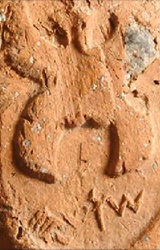Print Article
Author's Bias | Interpretation: conservative | Inclination: dispensational | Seminary: none

© Eliat Mazar
In 2009, while excavating the Ophel (the foot of the southern wall of the Temple Mount), a team of archaeologists
under Eliat Mazar discovered a bulla of Hezekiah king of Judah.
Amid a cache of 33 ancient bullae, the Hezekiah bulla was recovered in a refuse dump that was
adjacent to a royal building that stored food. Typically used to seal and authenticate papyri documents, many of the
bullae instead had impressions of coarse fabric and thick cords; these bullae were likely used to seal food sacks.
Dated to the second half of the 10th century B.C., the royal building that stored food was
constructed during the time of king Solomon.

Unprovenanced Hezekiah
scarab bulla
© Robert Deutsch
The impression of the Hezekiah bulla measured 9.7 X 8.6 mm, and the bulla itself measured 13 x 12 mm.
Writing Direction: The ancient Hebrew starts from the bottom to top.
Translation: Belonging to Hezekiah [son of] Ahaz king of Judah.
Symbol / Emblem: A sun disk emitting six sun rays (3 short rays from the top 3 long
rays from the bottom) with a crosshatched wing on each side pointed down.
Over the years, several bullae belonging to Hezekiah have been recovered from the antiquities market with
unknown provenance, which always leaves open the possibility of forgery. This Hezekiah bulla was the first one
recovered from a scientific archaeological excavation and confirmed the main observation of previous Hezekiah
bullae; Hezekiah was the first king of Judah to use an emblem in his bulla. A unprovenanced bulla of king Ahaz,
Hezekiah's father, had only an inscription and lacked any emblem or symbol.

2-winged sun jar handle
|

4-winged scarab
|
To this date, among the unprovenanced Hezekiah bullae recovered from the antiquities market, 2 have the same
sun disk with wings as Mazar's Hezekiah bulla, and 6 share the same translation but show a different emblem: a
scarab.
Writing Direction: The ancient Hebrew starts from the top to bottom.
Translation: Belonging to Hezekiah son of Ahaz king of Judah.
Symbol / Emblem: A 4-legged dung beetle (scarab) pushing a ball of dung with a laced
wing on each side curved upward.
This indicates that Hezekiah employed at least two different emblems on his bullae!
The possibility of Hezekiah using two different emblems was proposed decades earlier by Israeli archaeologist
Yigael Yadin who concluded that similar impressions of two different emblems were observed on royal jar handles
firmly dated to the reign of Hezekiah.
Jar handles stamped with the ancient Hebrew LMLK (pronounced "l'melekh" which means "belonging
to the king") distinguished a jar as being of royal property.
Nearly 4,000 l'melekh jar handles have been recovered and associated with Hezekiah's reign, and
the emblems they have are either: 1) a 2-winged sun disk with or 2) a 2 or 4-winged scarab.
In comparison to the emblems found on Hezekiah's bullae, the emblems on the l'melekh jar handles
are 7 times larger. Scholars consider these impressions more for government administration rather than as Hezekiah's
personal seal.
The emblem of the 2-winged sun disk, with or without its sun rays, has upswept wings.
The emblem of the 4-winged scarab, 2 upswept wings and 2 down swept wings, is not pushing a
dung ball.
Because the winged scarab and sun were commonly used symbols of power in Egypt and Phoenicia, most scholars
believe that this influenced Hezekiah to appropriate them for the same symbolism of power / royalty. Among a few
scholars, some debate whether Hezekiah attached any religious meaning to these emblems (i.e. the winged sun
proclaimed God's protection, etc.).
Data from the excavation of Mazar's Hezekiah bulla suggest that the winged sun bulla was made
late in his life. This indicates the possibility that the emblem, used for both government administration and
Hezekiah's personal seal, started out as the winged scarab and changed later in his reign to the winged sun. The
change may reflect the waning political influence of Egypt to the ascendance of Assyria and / or the influence of
Hezekiah's relationship to God.
Hezekiah, who reigned 727-797 B.C., would be known for his religious reforms and revival rejecting the apostasy
of his father Ahaz (2 Ki 18:1-6), the defense of Jerusalem against
Sennacherib and the Assyrians (2 Ki 18:7-19:37),
and the repentance of his sin of pride (2 Chron 32:24-26).
References:
1. From the Hebrew University of Jerusalem website: Impression of King Hezekiah's Royal Seal Discovered in Ophel Excavations South of Temple Mount in Jerusalem.
2. Deutsch R, "Lasting Impressions: New bullae reveal Egyptian-style emblems on Judah's royal seals" in Biblical Archaeology Review, 28:4, (2002).
3. From the LMLK Research website: King Hezekiah's Personal Seals.
Copyright ©
2018
Helpmewithbiblestudy.org. All rights to this material are reserved. We encourage you to print the material for personal and
non-profit use or link to this site. If you find this article to be a blessing, please share the link so that it may rise in
search engine rankings.